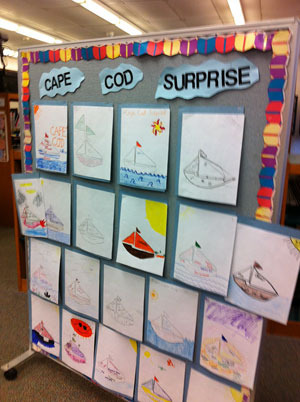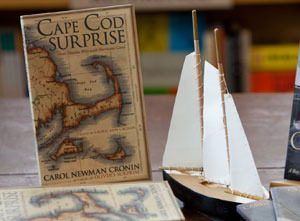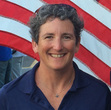Carol Newman Cronin's Blog, page 61
March 2, 2012
Ideas are the Easy Part: Teaching with Cape Cod Surprise
Yesterday I visited the Bourne Middle School, writing Oliver-based stories in cooperation with about 230 fifth graders—who fortunately were divided across five forty minute periods, and well-supervised by their teachers. First the kids chose a starting and ending point for our story and located each on a chart of Buzzards Bay, establishing our setting. Then I laid down two ground rules: Oliver can't die, and the schooner Surprise (represented by a not-to-scale homemade replica: see photo below) couldn't sink. Other than that, it was up to them to write the story.
Naming the Villains
The best part was choosing a tasty name for our villains. My favorite for the day was "Bloody Eyed Erin," but we also had "Red-handed Jill," (she had closed a door on her hand), "Dr. Platypus," and "Captain Crunch" (who, of course, had cereal stuck in a mangy beard).
Once we'd established the main characters we "wrote" our story, moving Surprise across the chart every time a major plot point was established until we reached our destination. It wasn't always a linear progression, and the hardest part was deciding when the story was really over; there were always more ideas begging to be included.
Suggestions came faster than the scribe could write them down, and twenty pages of notes just cover the highlights. We had sword fights and a frying pan used as a shield, treasure chests and gold eye patches, octopi and friendly mermaids.
Teaching Moment
Along the way, a few ideas popped up that (even to a non-teacher) screamed out, "teaching moment!" In our story about going back in time to Hurricane Bob (way back in 1991), one red-headed boy said "My mom told me that whales came into Phinney's Harbor during the hurricane, so I think whales should help Oliver push Surprise off the rocks." He'd already figured out how to adapt an anecdote for use in fiction.
What made the day so successful was the kids' inate sense of story. After any overly off-beat suggestion (ninjas, robots, icebergs) I'd ask, "Does that belong?" The response would be a resounding chorus: "NO!"
"Where do you get your ideas?"
Once we reached our destination, I'd ask for questions. Someone would inevitably ask, "Where do you get your ideas?"
It wasn't until the third period that I connected the dots… and started throwing the question back at the kids. "How many ideas did we just come up with in twenty minutes?" I asked.
"Lots," they responded. "Hundreds."
"And how many of those ideas would you want to live with for long enough to write a real story?"
An answer came immediately from one girl in the front row: "Three."
"So now you know," I told them. "The ideas are the easy part."
These kids face the same writing challenges that I do: finding the patience to sift through all those raw ideas and choose the one that will grow into something larger than itself; having the follow-through to edit that idea into a beginning, middle, and end; and—most challenging of all—tossing out the beloved possibilities that just don't fit the story.
It was a great day, bathing in an ocean of ideas. Best of all, it gave me an answer to "Where do you get your ideas?" From now on I'll tell anyone who asks, "I go and talk to fifth graders."
February 23, 2012
The Shape of a Story
Several years ago, I wrote a story called "Reading the Shape of the Wind." In it I described the different ways breeze fills across the water, as well as the best strategies for winning races in each condition.
Recently, it's occurred to me that there's a shape to each story I write as well. Perhaps that's because stories—like wind—have different causes. The heat of rising anger might cause a summer seabreeze of a tale. The pressure differential between two characters might bring on a gradient wind, the humidity level a sure indication of its direction: cool and dry—from the north; warm and damp—from the south.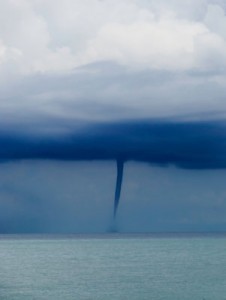
The geographical location of a story affects its shape as well, just as the wind's character is determined by latitude and location.
One of the wind shapes I wrote about also applies to story-writing: helicopter puffs. Though not always caused by the beating rotors of photographers zooming in for the money shot, the literary equivalent would be a series of sudden bursts of detail that land on the surface of the story, just in time for the main character to react. The best of these provide just enough information to keep the reader turning the page, while also spicing up a story line that otherwise would be too linear or predictable.
Then there's the circle, a shape that has no significance for sailboat racing but definitely factors into story-writing. The best stories come back to the same place—or almost the same place—to find the characters changed by what has occurred. Like a tornado, that circular shape stirs up everything nearby, rearranging and maybe damaging people and property in the process.
My stories are not as loud or as violent as tornadoes, but they usually come back to where they started. Oliver's journeys back in time would not be complete without a return to his own century. Only by seeing him back in his own environment do we realize how much his adventure has changed what's important to him.
I'm currently working on something new, and though I know the geographical location I can't yet identify the story's shape. It's probably closer to a seabreeze or a gradient wind than a tornado, and the humidity levels are high. Before it's finished I'll make sure to drop in some helicopter puff-details, just to keep you all guessing.

February 16, 2012
Presenting Game of Sails on Paper
You heard it here first: Game of Sails: an Olympic Love Story will soon be available in paperback.
I've heard from many fans that they aren't interested (yet) in ebooks but really want to read my latest novel. And I also heard from a few local stores that a paperback GoS would be a great seller this summer. So I've decided to go ahead. What a great way to celebrate an Olympic year!
A celebration, but also a time sink. The past few weeks, much of what is usually my writing time has instead been spent on presentation.
While ebooks provide their own formatting challenges to make the reading seamless across a range of devices, paperback book design is both harder and more permanent. There are specific rules for page size and the order of important information like copyright and acknowledgments (though that seems to vary from one publisher to the next). And if you don't get it right the first time, you can't just upload a new file.
Unlike most authors, I've got enough design experience to format my own books. GemmaMedia, the publisher of both Oliver books, hired me to design the cover as well as the interior for both Oliver's Surprise and Cape Cod Surprise. In the past four years, we've received many compliments about the designs. Glyphs, font choices, and whether to right-justify or center an author's note are all items of interest for me, but that means investing a substantial amount of time into getting the details right.
The last time I formatted a paperback was two years ago, when I designed Cape Cod Surprise. I'd conveniently forgotten how time-consuming page numbering, chapter numbering, pagination and margin-tweaking are.
And when that's done, there's still the cover to finish. I love the ebook cover I designed for GoS, but it's only the "front" cover. The all important back cover (home to so many important items like pitch, blurbs, and author bio) is the hardest part to get right. There are so many disparate pieces of text and information that all need to be integrated into a seamless and appealing sales tool.
So that's what I'll be doing as February winds down. Designing, editing, proofing.
So those new characters of mine who are waiting to be potty-trained? They have a few more diapers in their future.

February 9, 2012
Balancing Between The Fulcrum Files and Real Life
I both love and hate getting completely lost in a book. I love it because the story takes me places I could never go otherwise… like back to 1936, on England's south coast. I hate it because losing myself in fiction makes it hard to be present in my real world—and usually keeps me up way too late. In the case of Mark Chisnell's latest thriller, The Fulcrum Files, the story stuck with me long after I finished the last page. 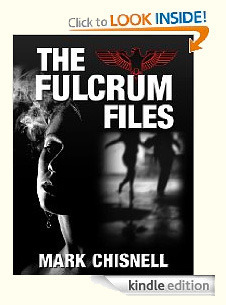 I kept wondering what the characters were doing now, which other readers will recognize not as a sign of insanity but as the mental residue of getting lost in a great story.
I kept wondering what the characters were doing now, which other readers will recognize not as a sign of insanity but as the mental residue of getting lost in a great story.
The book centers around Ben Clayton, an unlikely hero who's given up success in the boxing ring to become an engineer. When a friend and fellow worker is killed in a suspicious accident, Ben is drawn into an international maelstrom that the reader knows will eventually erupt into World War II. Most of the characters are in denial about the threat of another war, since they are still exhausted by the last one. The reader's knowledge adds another level of tension—and realism—to the story.
The best historical fiction overlays a small world story onto real life events. It's easy to imagine Ben and his long time girlfriend Lucy making their way along the Hamble waterfront, and equally easy to imagine Ben getting talked into a trip to Germany with the sleek and fancy Anna. So easy that I continued to picture scenes in my head, long after I'd finished reading.
Chisnell is a sailor, but this book requires no boating knowledge of any sort. Waterfront scenes will be easily understood, even by those who don't care to know the difference between "bow" and "stern."
The one thing that distracted me from the story (maybe because my European History degree is a few decades old) was the difficulty I had keeping track of everyone's loyalties. But that also plays into the multi-layered mystery of this book; no one is quite who he or she seems to be—except our main character. Ben Clayton grounds this book with a gritty straightforward honor, and even though he seems to get himself into trouble a bit more often than he should, he never lets the reader down.
Anyone who likes thrillers, historical fiction, or The Riddle of the Sands will enjoy this book. Do yourself a favor and find a way to balance real life with The Fulcrum Files; you won't regret it.
February 2, 2012
Where Work Meets Play: Miami, Florida
Greetings from sunny south Florida, where I've escaped for a week of warm weather and a spot of fun that might (or might not) be eventually justified as research. For the past twenty years, I've come to Miami for one or more of the many regattas that are hosted here during the winter months. This is the first time I had a completely free day without the distractions of meetings or sailing, and I took full advantage by making a trek to the Barnacle.

Commodore Ralph Munroe's boat Kingfish was half of the original payment for forty acres on Biscayne Bay. Photo: HistoryMiami Archives & Research Center.
I'd always wanted to visit the historic park, which is a slice of Old Florida hemmed in on three sides by condos and busy streets. Thanks to the hard work of preservationists and descendents of the original owner, Commodore Ralph Munroe, a slice of tropical hardwood hammock has been preserved that runs from Main Highway (a Coconut Grove drag strip of restaurants and bars) all the way down to the shoreline of Biscayne Bay. Once enveloped in the leafy quiet of tree canopy, visitors are transported back to the early twentieth century—a time when sailboats were still the best form of transportation.
The Commodore built his home, the Barnacle, in 1891, and since then it's withstood several minor hurricanes as well as the two big ones in 1926 and 1992 (Andrew). It's also self-cooled, thanks to a cupola that allows hot air to escape through the roof. Boat-inspired cabinetry shows Munroe's love for yacht design.
Down on the shore, the boat house (built in 1886, and then rebuilt after the 1926 Hurricane) feels as if the yacht designer has just stepped away for a moment, leaving tools and a half-finished project on the bench. And enough of the marine railway has been preserved to visualize how boats were launched and hauled in the shallow bay. Best of all, trees hide the high rise buildings of Coconut Grove and downtown Miami, allowing visitors to imagine they have truly stepped back in time.
My original reason for a visit to the Barnacle was the tickles of a new Oliver story. Even if our favorite time traveler doesn't choose to come here, I'm glad he inspired me to visit. The Barnacle gives us all a glimpse of a Florida that's less than a century in the past—but is an entirely different world in terms of priorities, landscaping, and transportation. It's well worth a visit for anyone interested in boatbuilding, Florida history—or even time travel.
For more information, visit the Barnacle website. A reprinted edition of The Commodore's Story by Ralph Munroe and Vincent Gilpin is also available. And the Commodore's excellent photographs offer a glimpse into the past online, via these archives:
Historical Museum of South Florida
HistoryMiami Archives and Research Center
University of Miami Libraries
January 25, 2012
Ebook Lending: the Good, the Bad, and the Not Quite There
This post was written for Beyond the Margins, an excellent source of writerly wisdom and (sometimes) hilarity. I've since updated it, based on comments on that blog and some other recent news stories.
There are bookstores, there are libraries—and then there's my friend Kim. Every time we get together, she hands me a book. It's usually a story I really enjoy, and it is always one that leads me into a new world. Best of all, I haven't had to go seek it out anywhere—the Kim books come to me.
I also pass her carefully selected books, and this inter-friend loan is one reason I didn't adopt ebooks more quickly. But as we head into 2012, it is now possible to loan an ebook to a friend. We can even take ebooks out of the library.
Now at first, all this ebook lending and borrowing might not seem like it has any benefit to authors. But I would argue that increasing book availability will help reading compete with all the other entertainment options. Borrowers are not always would-be buyers, but they might recommend your book to a friend (or two) who will want to own it. As the logistics smooth out, ebook borrowers will be no different.
Here's a peek at how it all works—and my vote on whether it's good, bad, or not quite there.
Ebook Loans
Loaning ebooks from a personal library is an option for both Nook and Kindle owners. Both programs are an opt-in for publishers, but hopefully as the system proves itself, more and more books will be included.
The loan is valid for fourteen days (during which time you do not have access the book), so your friends can't leave it wallowing on their virtual bedside table for too long.
I did some digging around the Barnes and Noble site and I have to say I wasn't impressed. One link from the home page to the LendMe Books page was actually broken; even when I finally got there, there was no explanation—just a "Top LendMe NOOKBooks" table of book covers. I'm guessing you can loan ebooks you own to friends/family who also have NOOKs, but a detailed search for program rules led me nowhere. And the most avid NOOK user I know (my hairdresser) hadn't even heard of the program.
Update : another Nook owner reports that all the info you need about LendMe Books is included in the Nook User's Guide, which is included (of course) on every Nook.
By contrast, the Amazon Kindle lending program makes it very easy to share ebooks from your library with any U.S. resident. The borrower can download the book and read it on any platform with a Kindle app. Sharing a favorite ebook becomes almost like handing over a paper copy. Best of all, the return is automatic.
Amazon Prime members can also borrow one ebook per month (which some speculate is a trial run at offering a subscription-based Netflix-like library). There's no due date on these books, so you can read them as slowly as you want. Love 'em or hate 'em, Amazon is by far the easiest way to borrow and lend ebooks.
Library Loans
For the library lover, all you need is a valid library card to check out an ebook. It may not come from your favorite library, but with digital transfers the actual location hardly matters.
From my local library's website I can access the Ocean State Libraries E-Zone page. From there I can browse for a book—though I won't pretend it's at all comparable to pulling a crinkly plastic-wrapped hardcover off an actual shelf and inhaling the musty scent of stored paper. Once I've selected what I want, I enter my library card number and desired format (Kindle, ePub, PDF, or Overdrive).
So far, books I've chosen are only available for a "hold." When the title becomes available, which is usually after a few days, I receive an email and have three days to download the book.
I'm guessing this is because demand currently exceeds supply, and I expect this will become more instantaneous in the not too distant future. Ebook libraries are still in their evolutionary infancy; even in the two months since I borrowed my first ebook, the process has improved dramatically.
This system has also brought up new concerns about privacy. The Kindle version is borrowed through the Amazon Manage Your Kindle page, which means that Amazon is keeping track of what you borrow. At least in California, that may be illegal under the Reader Privacy Act. Stay tuned for more developments on this topic.
Update: A recent Wall Street Journal article makes it clear that library elending is growing fast in popularity. "Amazon declined to say how many e-books have been borrowed, but in the past month, registrations have doubled on the New York Public Library's website. Each day, the library's website averages 2,000 e-book checkouts and signs up about 200 new users." Read the full article (Warning: Link may expire after a few days.)
I'm enough of a believer in ebook lending that I'm going to look into donating electronic copies of my three books to my local library network—one very small drop in the bucket of ebook lending supplies. I'll be able to share my books with a wider audience by helping to fill the virtual shelves of libraries within the local network.
Ebook lending may not be as wonderful as receiving the perfect pre-selected read from Kim, but it's definitely moving in the right direction.
January 18, 2012
Story Parenting: Am I Raising my Characters, or are they Raising ME?
 Now just for the record, it's important to make one thing perfectly clear: I'm not a parent. I can't remember the last time I changed a diaper. And I've never had to decide how much freedom to give a teenager, or when to take away the keys to the family car.
Now just for the record, it's important to make one thing perfectly clear: I'm not a parent. I can't remember the last time I changed a diaper. And I've never had to decide how much freedom to give a teenager, or when to take away the keys to the family car.
So you may decide I'm not qualified to write this post. Because I'm about to compare writing novels to rearing children.
Recently I started a new-from-scratch book. New characters, new issues, even a whole new island to explore. I'm listening as these newcomers talk, with only a vague idea of how they relate to each other or how they will impact the story.
Many authors know these basic traits before they start writing. The very first entry in the Scrivener character description template (right after the name) is "Role in Story," even before "occupation" —which is how most folks living in what we call the real world orient themselves.
Obviously that template was designed by an outliner.
With many of these new characters, I have to just leave that section blank. I don't know most of them well enough yet to figure out how they will interact with this new rock I built under them, or what impact their personalities will have on their world.
Suddenly I'm bottle-feeding these characters of mine, watching them react to a change in the light or another person entering the room. Laughing at the first words, the gestures that were somehow already familiar even before I wrote them down for the first time. Best of all, now that I've given up trying to write a perfect book as a first draft, I'm really enjoying this stage too. Getting to know these new not-quite-people is FUN!
I tried outlining, honest I did. Thinking I could take a shortcut to character development. And then when I sat down to write, those characters (who looked so good on paper) refused to talk. Or worse, decided to veer off into the unknown again. So I've gone back to my old inefficient methods: listening to them speak, and then following them almost anywhere they choose to go.
Now having a needy baby (or actually, a whole town full of babies) in the house is a major change of lifestyle. And since I haven't started anything so completely new in over five years, it's even more of a shock. Oliver's Surprise, Cape Cod Surprise, and Game of Sails have all been sent out into the world to fend for themselves, and they are all doing just fine. Game of Sails did come back a few weeks ago to ask for a print version, and all three books will likely be on my health insurance for as long as the goverment allows… but the characters are all grown up. I know them better than some members of my actual family, know their habits and their mannerisms and—most importantly—their Role in Story.
They in turn know who serves the best coffee in their towns, who's honest and who's not, who to turn to in a crisis. Most are even on a first name basis with the local post office staff—and not because their pictures are on the wall.
Best of all, that pesky editing that turns a toddling first draft into a running, leaping, minivan-driving teenaged real story is already behind us.
Like any new parent, I'm both excited and exhausted by the prospect of raising all these new characters. I'll try to have some say in their development, but I can already tell: they're stubborn, all of them. These characters are not really unformed, they are just as yet unknown to me. As Michael Haskins recently wrote in Who's Writing this Story?, "It happened without my doing it. The character popped out with something from earlier in the book. Something I never gave a thought to, until I looked for an ending."
I can't wait to give each one the keys to the family car.
January 12, 2012
Writing: It's Not a Competition
Back in 2006, I attended the New York Writer's Group Pitch and Shop. I was a complete newbie to the publishing world, desperate (just like the other 40 or so writers present) to find an agent. Instead I found fellow writer Roberta Gately, who was even shorter than me—and probably even more determined to get published. Her no nonsense attitude drew me in immediately, and we kept in touch once the conference ended.
Two years later, Roberta was one of the first people I told when Oliver's Surprise found a home with a publisher. And even though she hadn't yet found a publisher for Lipstick in Afghanistan, she was so ecstatic for me she called with congratulations. Her genuine enthusiasm taught me something extremely valuable: we are NOT in competition with our writing buddies.
Fast forward another two years, and I got a reciprocal email from Roberta: Lipstick would come out the following year! She also invited me to join a fledgling Writer's Promotion group based in the Boston area. Though it was a bit of a hike from Rhode Island, I attended several meetings—and was thrilled to be included in planning sessions for the book launch parties of Randy Susan Meyers, Holly LeCraw, Juliette Fay, and Iris Gomez. I'm looking forward to a few more when Nichole Bernier and Kathy Crowley launch. And hopefully we'll see another book from our token male, Chris Abouzeid, one of these days, too.
I've learned a ton from these generous writers, and hopefully I've provided a little knowledge (at least about sailing) in return. And this week I was thrilled to be the guest author of a post on Beyond the Margins, an excellent source of writing and authorly information (spiced with humor) created and maintained by several in our writer's promo group.
Watching my blog post appear and reappear on several social media sites throughout the day served as a series of reminders: this is not a competition. For those of us used to measuring our success in racing terms (winning, on the podium, top ten, top half), it's a big adjustment to realize that more books is more better. Yes, someone may put down my book in a store and choose another to buy instead, but if my book has done its job, that same buyer will be back to claim it on the next shopping adventure. The more we support each other, the better we all do. A rising tide of enthusiasm lifts all (sorry) authors.
And it's also a whole lot less lonely when you've got writing buddies.
So thanks to everyone who has tweeted, friended, plussed, or just plain BOUGHT my work. In the words of another friend who is also an excellent writer, "We sail on together, we sail on alone."
January 5, 2012
Ebook Reformatting: Game of Sails, Take Two
As most of you know, I published Game of Sails in July 2011 as an ebook. I carefully created the Word document specified in the Smashwords publishing guide, reviewed the book on my computer and iPhone, posted it on Smashwords, Amazon, and Barnes and Noble—and thought I was done. I looked forward to moving on to the next project, and spent the fall researching new topics and locations.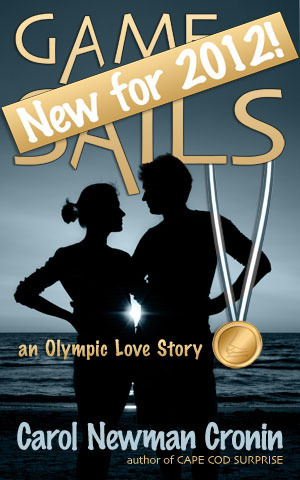
Meanwhile, I kept up with the comments and reviews on a variety of sites. None said anything about formatting issues, so it wasn't until I became a Kindle Touch owner in November that I realized the book had a major flaw: several of the paragraphs were indented too much. Worse yet, those paragraphs didn't have an extra indent for the first line, which made it really difficult to see where a new paragraph began. How distracting!
Obviously I'd have to reformat the file. So while I was at it, I decided I'd go through another text edit. I also decided (you heard it here first) to change the perspective back to third person for two of the characters.
Many reviewers said they were confused by reading different perspectives in first person. One said "I found myself having to consciously think about who was speaking." That sounded like a distraction that was best avoided.
So just before Christmas, I took a deep breath… and began editing. Find/replace took care of the most obvious changes ("I" to "she," "me" to "him"), but there was no escaping the need for a careful look through to catch more subtle errors. What sounds perfectly fine in first person often sounds awkward in third person, which led to some rewording.
Along the way I also corrected a few typos and eliminated some unnecessary fluff that had previously escaped the editor's red pen. And even though it took me much longer than I'd planned, the result is an even better book.
As an added bonus, I've also included a sampling of Oliver's Surprise at the end of the new version. The original had a link to an online excerpt, but now even those of us who like to stay in the "moment" can enjoy a taste of Oliver's world.
As for the formatting, that's improved too—thanks to writer and game designer Guido Henkel. A prime example of the incredible online support community available to indie authors, Guido took the time to put together a step by step guide called "Take Pride in your Ebook Formatting." Formatting errors are very common with ebooks (from major publishers as well as indies); with so many different ereaders on the market, it's very important to produce a file that will format consistently across all platforms.
I'm still wondering how Guido found the time to write such a great guide while also writing a series about Jason Dark, Ghost Hunter, AND responding so promptly to all his comments. But I (like so many of his commenters) very much appreciate the time he saved me with his excellent information.
So I'm ringing in 2012 with a second edition of Game of Sails, which should be available by January 7 "wherever ebooks are sold." And while I doubt the first edition will ever become a collector's item, I'm going to save it anyway… because as fast as this world is changing, you never know.
December 29, 2011
The Gift of KindleTouch, and Toasters
Last week, I promised to let you know how the "best" present of this year was received. Of course, I said it was the "best" present because I didn't know about the Makita drill and new toaster oven that Santa was bringing to me… 
Good thing I didn't let on in last week's blog what the present was, since its recipient (my mother) is a devoted reader. Now that the gift giving is complete, I can share the secret with you all: my dad gave my mom a Kindle Touch for Christmas.
Her initial reaction? A controlled snort. Which meant (at least to these ears) "this is too much."
Mom is usually the last adopter of new technology in the family. She's not intuitively comfortable with gadgets, so she needed some help with setup and downloading. But after some initial direction, she figured it out. And surprisingly quickly, she (like every other reader who's made the e-leap) forgot about the device and focused on the story.
One reason the adoption was relatively seamless is because I had pre-ordered a gift book I knew she'd enjoy: The Widow's War by Sally Gunning. Turning on a Kindle with no books installed is like turning on a computer with no software… or walking into an empty room expecting a party. She wasn't fooled by the "welcome letter" from Jeff Bezos, and she definitely wasn't interested in reading either of the pre-loaded dictionaries. So it was important to have something she'd enjoy that was available right away.
I'd also given her a Kindle Touch cover, so as soon as she unwrapped the Kindle she snapped it on. I'd used my Kindle Touch naked for the first month, so I knew it would be much easier to hold and much more book-like once she had this "necessory."
One week later, she's still sorting out a difficulty with the wireless downloads. But in spite of that technical glitch I consider this "best" present of 2011 a success.
As for the toaster, it has been a large improvement over its replacement. And the Makita drill will be a great addition to my tool kit for 2012 and beyond. Thanks, Santa!
And thanks to all of you for sharing this journey. Enjoy the transition into a new year!

